⚡ZurzAI.com⚡
Companies Similar to Adasky
Wayve

Wayve develops AI technology for autonomous driving, raising over $1 billion for its innovative, scalable Wayve AI Driver, and securing investments from SoftBank and Uber.
About | About | About | Locations | About | News | Contact | Careers | Careers | Careers | Careers | Careers | Leadership | About | About | About | Vision/Values | Leadership | Leadership | Leadership | Leadership | Leadership | Leadership | Leadership | Leadership | Leadership | About | Leadership | About
Wayve AI focuses on developing advanced autonomous driving technology through its innovative application of Embodied AI, a holistic approach where AI learns from and interacts with real-world environments. The company’s core mission is to redefine how autonomy is perceived and implemented in the automotive industry by enabling vehicles to perceive, predict, and react to dynamic real-life scenarios with enhanced intuitive understanding and safety.
Strategic Focus and Unique Value Proposition:
-
Embodied AI for Autonomy: Wayve’s key strategic focus area is the development of end-to-end AI solutions for autonomous vehicles (AVs), leveraging Embodied AI’s capability to dynamically learn and interact with real-world scenarios. This approach attempts to simulate a human-like driving experience that generalizes better across diverse environments without the need for HD maps.
-
Universal Compatibility and Scalability: The company is creating AI software that does not depend on specific hardware or HD maps, making it adaptable across various vehicle types and geographies. This universality offers substantial flexibility and scalability, crucial for quick integration across different vehicle models and geographic locations.
-
AV2.0 Approach: Wayve’s advancement to AV2.0 claims to leapfrog traditional autonomy models by utilizing data-driven, self-supervised learning that circumvents the high costs and limitations of extensive labeled datasets and rigid planning modules.
Delivering on the Value Proposition:
-
Wayve AI Driver: Wayve offers the AI Driver software designed to enhance driving automation from basic assistance (L2+) to advanced autonomous capabilities (L4). This platform allows for mapless, hardware-agnostic functionalities, aiming to streamline integration processes for automakers and fleet managers.
-
Fleet Learning Loop: The company employs a fleet learning loop that continuously improves the AI's driving capabilities through real-time data processing, training, and model evaluations, using a robust cloud infrastructure that supports global operations.
-
Safety 2.0 Framework: Safety is integrated into Wayve’s AI through its Safety 2.0 framework, which prioritizes generating introspectable and safe driving responses. It leverages generative AI to predict and react efficiently to unexpected driving scenarios, reinforcing AI safety mechanisms through comprehensive data analytics.
-
Generative AI Models: Wayve’s advancements include GAIA and LINGO models, which enhance the AI’s understanding of driving environments and natural language processing, respectively. These models are intended to improve decision-making and reasoning transparency, while accelerating autonomous vehicle training with realistic driving simulations.
-
Partnerships and Collaborations: The company collaborates with industry leaders such as Microsoft for supercomputing capabilities and fleet operators like Ocado and Asda to trial its AI in real-world applications. This strategy helps in accumulating diverse operational data, further refining its AI models.
Wayve’s strategic advantage revolves around its adaptable and scalable AI solutions that aim to transform the automotive industry’s approach to autonomy, pushing boundaries in the realms of safety, efficiency, and user adaptability. Through continuous research and partnerships, Wayve seeks to pioneer autonomous technology that can be seamlessly adapted across varying global markets and needs.
Mapillary

Mapillary provides street-level imagery and map data, enabling global collaboration for enhanced mapping, improved navigation, and support for autonomous driving technologies.
About | About | About | About | About | About | About | About | About | About | About | About | About | About | About | About | About | About | About | About | About | About | About | About | About | Vision/Values | About
-
The company's key focus area: The company, Mapillary, is centered on a platform for crowdsourcing, sharing, and utilizing street-level imagery to build better maps and data solutions. It aims to provide an innovative approach to creating detailed, up-to-date, and accurate street-level views through a collaborative framework involving a global network of contributors.
-
The unique value proposition and strategic advantage: Mapillary distinguishes itself by leveraging a distributed model where individuals and organizations can upload street-level photos, enabling them to crowdsource extensive visual data on a global scale without relying solely on proprietary systems. This approach allows the company to rapidly amass a comprehensive database of images that power a multitude of mapping applications. Their strategic advantage lies in their capability to update, process, and analyze these images in real-time, thus keeping pace with changes in the urban landscape more efficiently than traditional methods.
-
How they deliver on their value proposition: To deliver on its value proposition, Mapillary employs a robust platform equipped with advanced computer vision technology to map the world through various contributors efficiently. Key elements of their operational framework include:
-
Crowdsourced Participation: Users contribute by capturing and uploading images, which is mediated through Mapillary's user-friendly mobile applications and integrations with off-the-shelf devices, enabling ease of access for anyone wishing to contribute.
-
Advanced Image Processing: The company processes uploaded images with state-of-the-art image recognition and computer vision technology to extract data points and map features, which include detecting objects, text, signs, and more. This advanced data processing capability enables the conversion of raw street-level imagery into useful map data.
-
Cross-Sector Collaboration: Mapillary partners with various stakeholders, including city planners, mapping services, automotive companies, and community contributors to ensure the comprehensive usage of its data for urban planning, navigation systems, route optimization, and similar applications.
-
Mutual Accessibility and Integration: By offering APIs and integration options, Mapillary makes it easy for developers and companies to incorporate its data into their existing systems. Their partnership with mapping software enhances the quality and precision of existing geographical data, improving navigation and spatial analysis tasks.
Through these systems and collaborations, Mapillary proposes a transformative way to handle street-level imagery and mapping that can adapt to a rapidly changing world, redefining how geographical data is collected and utilized.
Aurora Innovation

The Aurora Driver aims to enhance safety and efficiency in logistics through advanced autonomous driving technology, collaborating with partners like Volvo for deployment.
About | About | About | About | About | About | About | Contact | About | About | About | About | About | Leadership | Directors | Leadership | About | About | About | News
Key Focus Area:
Aurora's primary focus is on developing self-driving technology, particularly the Aurora Driver, which is aimed at revolutionizing transportation for both freight and passenger services. The company advocates for a future where autonomous driving enhances safety, reliability, and efficiency on roads while addressing key challenges in logistics and personal transportation.
Unique Value Proposition and Strategic Advantage:
Aurora's unique selling proposition lies in its purpose-built autonomous driving system, the Aurora Driver, which is designed to seamlessly integrate into a diverse set of vehicles, from trucking to ride-hailing cars. This innovation allows the company to cater to multiple segments within the transportation sector.
-
Partnerships: Aurora has established strategic collaborations with prominent players across the automotive and logistics industries, including Toyota, Uber, PACCAR, and Volvo. These partnerships are central to its development and scaling strategy.
-
Technological Edge: The system uses advanced technologies such as FirstLight Lidar for enhanced visibility and a custom computing platform for efficient processing. The focus on high-definition mapping, simulation, and motion planning ensures that their system is continuously evolving and improving.
-
Safety Framework: Aurora places a heavy emphasis on safety, backed by its comprehensive Safety Case Framework. This structured approach, alongside partnerships with safety advisory boards, aligns with its promise to advance the safety standards in autonomous vehicle technology.
Delivery on Value Proposition:
Aurora seeks to execute its strategy of making autonomous transportation viable and impactful through several key initiatives:
-
Technology Integration: By closely working with vehicle manufacturers, Aurora ensures deep integration of its driver technology to foster an autonomy-ready infrastructure. This integration is fundamental in efficiently deploying its technology on a large scale.
-
Operational Efficiencies: The autonomous freight service aims to mitigate current logistics challenges such as driver shortages and inconsistent driver supply. By eliminating traditional operational constraints, their system is built to improve logistic network efficiencies and cover substantial geographic territories promptly.
-
Adaptation and Growth: Aurora is actively involved in pilot programs with logistic companies to fit its service to specific business needs, allowing gradual adaptation of fleets to autonomous solutions. Additionally, it is continually training its Aurora Driver system through real and virtual world scenarios to strengthen its reactive capabilities.
-
Expanding Market Presence: The company is not only scaling its technologies for trucks but also progressing towards autonomous ride-hailing, facilitated by notable partnerships with Uber and Toyota. These projects focus on reducing the stress and cost of transportation, making mobility more accessible and equitable.
Overall, Aurora’s strategic approach is built on robust technology, collaboration with industry leaders, and an unwavering commitment to safety, positioning them as players pushing the boundaries of autonomous transport solutions.
Prowler.io
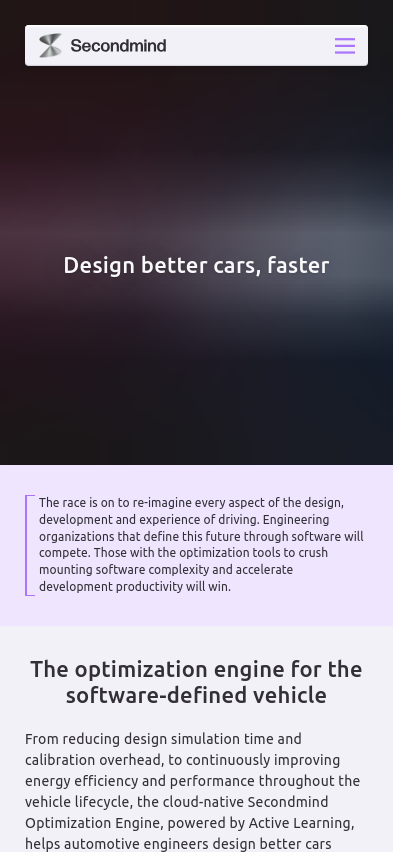
The article highlights Secondmind's Optimization Engine, which leverages Active Learning to streamline automotive design, improve efficiency, and support carbon-neutral mobility efforts.
About | Careers | About | News | About | News | Careers | About | News | About | News | Contact | Contact | Contact | About
Prowler.io is centered on advancing the automotive industry through the integration of sophisticated software solutions. Their primary focus is on developing optimization tools to effectively manage complex software challenges faced by engineering organizations. By doing so, they aim to enhance the design, development, and overall driving experience of vehicles, with an eye towards the rapidly evolving future of transportation.
Unique Value Proposition and Strategic Advantage:
-
Secondmind Optimization Engine: This cloud-native engine leverages Active Learning to improve the efficiency of automotive design processes. The engine aids in reducing the time needed for design simulations and calibration, as well as optimizing energy efficiency and vehicle performance.
-
Active Learning: The technology underpinning their solutions is versatile, applicable to a wide range of complex engineering scenarios. This enables automotive original equipment manufacturers (OEMs) to minimize data requirements and the number of iterations necessary to arrive at ideal design solutions.
Delivery of Value Proposition:
-
Automated Experiments and Data Modeling: The company's solutions include high-precision, data-efficient modeling to automate complex experiments, making the design process more efficient and less prone to error.
-
Explainability and Transparency: By providing explainable outcomes and transparent processes, Prowler.io ensures users can trust and understand the changes implemented as a result of their optimization strategies.
-
Cloud-Based Security: Their technology operates at cloud scale, offering secure and scalable solutions suitable for the changing demands of the automotive industry.
-
Research and Innovation: Prowler.io drives continuous innovation through its Secondmind Labs, where advanced machine learning technologies are developed to power their optimization solutions. This focus on research ensures the company remains at the forefront of technology improvements.
-
Strategic Partnerships: Engaging in strategic alliances, such as with Mazda, helps implement and refine their solutions in real-world automotive applications, thereby validating their technology and expanding its applicability.
Overall, Prowler.io positions itself as a strategic partner for automotive firms looking to navigate the complexities of a software-centric future while accelerating their journey towards carbon-neutral mobility.
Five AI

Bosch enhances automated driving software development by acquiring Five, aiming to accelerate innovation and improve autonomous vehicle technology.
- Key Focus Area:
Five.ai specializes in the development of autonomous vehicle technologies. The company's efforts are concentrated on creating systems that enhance the safety and performance of Autonomous Driving Systems (ADS). This involves developing platforms for faster and efficient autonomous vehicle development and ensuring safety through simulation testing, real-world analysis, and offline testing of Advanced Driver Assistance Systems (ADAS).
- Unique Value Proposition and Strategic Advantage:
Five.ai's value proposition lies in their platform designed for autonomous vehicle development, which emphasizes speed and safety assurance. Their competitive edge is achieved through:
- Scenario Simulation and Testing: Five.ai offers advanced simulation capabilities where diverse and complex scenarios can be created and tested. This allows for identifying potential faults and validating safety before public deployment.
- Scalability: Their system allows testing on thousands of traffic scenarios, enabling a comprehensive evaluation of systems under various conditions.
- Efficient Resource Utilization: Through simulations, Five.ai reduces the need for costly real-world fleets, thereby lowering development costs.
- Rule-Based Evaluation Framework: This ensures rigorous analysis of test simulations centered on specified requirements, fostering robust design iterations.
- Delivery on Value Proposition:
Five.ai delivers on its value proposition through several strategic implementations:
- Testing Environments and Workflows: They provide a robust infrastructure for large-scale tests covering development, progression, and regression testing. There's an emphasis on automating Continuous Integration (CI) tests.
- Real-World Triage and Assessment: Five.ai evaluates real-world drives, analyzing data to detect significant events accurately and efficiently.
- Research and Development: Five.ai maintains active research collaborations and continually publishes findings in AI and Machine Learning fields, indicating ongoing advancements in object detection, planning, and decision-making for autonomous vehicles.
- Innovative Technologies: Their adoption of recent methodologies, such as Self-Aware Object Detection and probabilistic models like DiPA for multi-modal prediction, exemplifies a focus on technological innovation to handle complex, dynamic urban driving scenarios.
In essence, Five.ai’s offerings are structured to provide a comprehensive ecosystem for autonomous vehicle testing and development characterized by efficiency, scalability, and safety assurance, underpinned by active research and cutting-edge simulation technologies.
Osperity

Osperity provides AI-driven intelligent visual monitoring for industrial operations. Osperity provides AI-driven intelligent visual monitoring for industrial operations, improving safety and reducing carbon footprints.
-
Key Focus Area: Osperity's primary focus is on providing intelligent visual monitoring solutions for industrial operations. Their offerings are designed to support a variety of sectors, including oil and gas, mining, construction, and utilities by employing advanced computer vision technology to enhance the monitoring and management of field operations, assets, and facilities.
-
Unique Value Proposition and Strategic Advantage: Osperity's strategic advantage lies in its ability to integrate advanced computer vision technology with a robust IoT (Internet of Things) infrastructure. This integration allows for exception-based management, enabling companies to automate observance of operations remotely while minimizing human intervention. The platform's key differentiators include:
-
Proprietary CV Toolkit: Enhances machine learning and optimizes CV performance.
-
Comprehensive Managed Service: Offers a cloud-based solution independent of corporate IT infrastructure, ensuring maximum uptime through cellular LTE network management and remote monitoring.
-
Customizable Alerts and Reports: Provides unlimited, customizable alerts and automated reports that are included as part of their managed service.
-
-
Delivery on Their Value Proposition: Osperity delivers on its value proposition through a multi-pronged approach:
-
Technological Integration: The platform integrates seamlessly with existing industrial sensors and systems, combining visual data with SCADA (Supervisory Control and Data Acquisition) and other platforms for enhanced situational awareness and alarm validation.
-
Ease of Deployment: As a cloud-based service, the platform requires no software installation and is designed to be easily deployable and managed, allowing enterprises to scale as needed while reducing total cost of ownership.
-
Real-world Application and Data Utilization: Osperity leverages a substantial dataset of tagged industrial images for testing and training its computer vision systems, maximizing the accuracy and relevance of its monitoring solutions.
-
Comprehensive User Support and Training: The company provides extensive remote training for all users and supports its technology with live phone and email support, ensuring operational readiness and user competence.
-
By focusing on these elements, Osperity seeks to improve operational efficiency, reduce downtime, and enhance the safety and security of industrial sites.
RoboK Limited
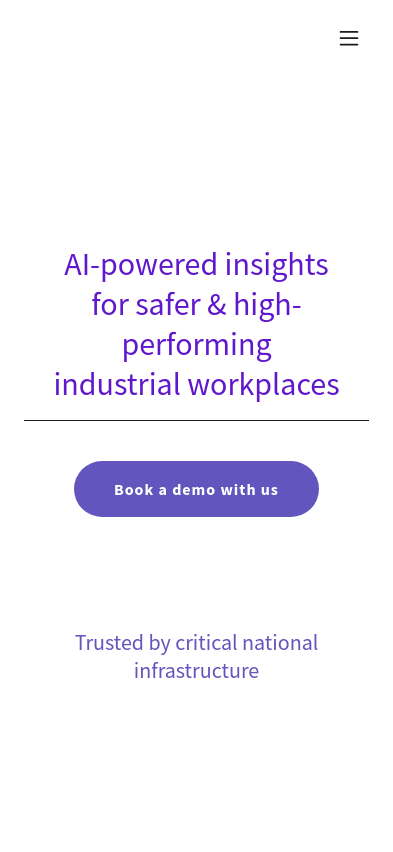
RoboK Limited develops ADAS & Autonomous Driving solutions focusing on reliability and safety for advanced driving systems.
RoboK's Key Focus Area:
RoboK is a computer vision start-up based in Cambridge, UK, with its primary mission centered on enhancing industrial workplace safety and performance using artificial intelligence (AI). The company specializes in transforming the operational effectiveness of critical infrastructure through the deployment of AI-powered insights derived from on-site CCTV cameras.
Unique Value Proposition and Strategic Advantage:
The unique value proposition of RoboK is the integration of AI with industrial CCTV infrastructure to automate and optimize safety monitoring and operational efficiency. By leveraging existing camera infrastructure, the company offers a cost-effective solution that transitions traditional manual monitoring processes into automated, AI-driven systems. This approach presents several strategic advantages:
- Optimization of Existing Infrastructure: By utilizing existing CCTV infrastructure, the need for additional hardware investment is minimized, making the solution not only innovative but economically feasible for their clients.
- Privacy-Preserving Technology: The emphasis on privacy-conscious development sets RoboK apart, ensuring their technology aligns with data privacy regulations and client expectations for data security.
- Actionable Insights: The transformation of onsite visual data into high-value insights allows for better decision-making and operational improvements across various industrial sectors.
Delivery on Value Proposition:
RoboK delivers its promise through the SiteLens™ platform, which enables several key capabilities:
- Always-On Incident Monitoring: The platform provides continuous monitoring capabilities by analyzing video streams to identify potential safety breaches and incident hotspots.
- Automated Safety Compliance: AI algorithms are applied to detect, classify, and categorize safety breaches, facilitating compliance tracking and reducing human labor in monitoring roles.
- Behavioral Analysis: The system monitors dwell times and asset tracking, identifying anomalies that could indicate inefficiencies or safety risks in real-time operations.
- Operational Insights & Reporting: SiteLens™ integrates with existing operational data to measure the effectiveness of changes and policies, providing key performance indicators (KPIs) and enabling data-driven decisions.
- Scalable and Integrative Approach: By integrating the AI platform with a client’s existing operational data systems, RoboK's services become integral to operational frameworks with minimal disruption.
By engaging customers with a freemium trial through demo requests, RoboK ensures potential clients can directly perceive the transformation capabilities of their AI solutions. The company's strategic approach focuses on fostering long-term partnerships with critical infrastructure operators, leveraging robust analytics and compliance monitoring to maintain continuous improvement and competitive advantage in industrial settings.
SenseTime
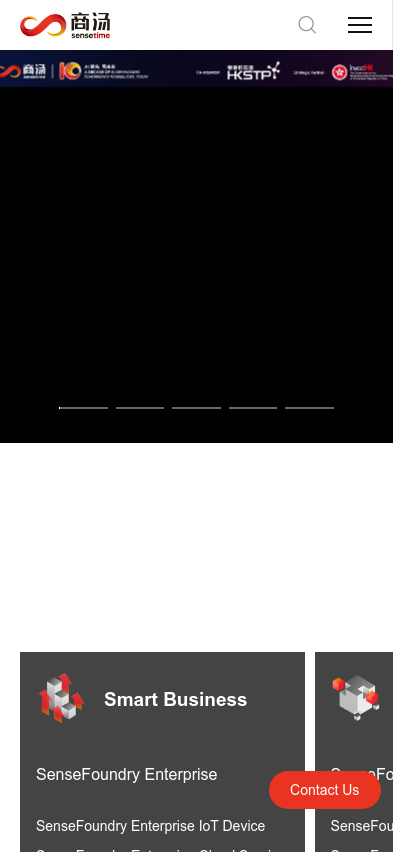
SenseTime is revolutionizing multiple industries by deploying its AI technologies and infrastructure, enhancing applications in smart business, cities, life, and automotive sectors.
-
Key Focus Area: SenseTime primarily focuses on artificial intelligence (AI) technology development and application, catering to diverse industry verticals. The company engages in creating AI-enhanced solutions for businesses, smart cities, smart life, healthcare, education, and automotive sectors.
-
Unique Value Proposition and Strategic Advantage: SenseTime's competitive edge lies in its proprietary technologies and its AI infrastructure, specifically the SenseCore AI Cloud. This infrastructure supports high computation capabilities and expansive algorithmic implementations, which lower costs and enhance scalability of AI applications. The emphasis on research and partnerships with academic institutions further solidifies its position, allowing it to integrate cutting-edge AI research into practical applications.
-
How They Deliver on Their Value Proposition:
-
Diverse AI Applications: SenseTime offers a multitude of AI-driven platforms such as SenseFoundry for businesses and cities, SenseME for smart living, SenseMARS for metaverse solutions, and SenseAuto for intelligent automobiles. These platforms serve to streamline digital transformation and enhance operational efficiencies.
-
Extensive Product Suite: The company's product offerings range from AI-enabled content generation and enhancement to medical image analysis, covering a comprehensive spectrum of AI applications.
-
Research and Development: SenseTime invests significantly in AI research, engaging with top universities and contributing to open-source projects. Their collaboration with The Chinese University of Hong Kong to offer OpenMMLab demonstrates their commitment to fostering innovation and adopting an ecosystem approach.
-
Technical Infrastructure: The SenseCore AI Cloud integrates AI chips and sensors, providing a robust foundation for processing substantial data and training large-scale machine learning models quickly. This infrastructure is crucial for the rapid deployment and adaptation of AI applications across industries.
-
Smart Solutions: In smart cities, simulations, and traffic management, they implement AI platforms like SenseFoundry to optimize and enhance public service functionalities and infrastructure efficiency. In the automotive sector, SenseAuto utilizes AI for safe and adaptive autonomous driving technologies.
-
Healthcare Applications: By leveraging medical image analysis tools like SenseCare, they aid healthcare workflows, targeting areas such as diagnosis, treatment, and recovery.
-
Innovations in AI: SenseTime's emphasis on advancements such as augmented reality and 3D reconstruction tools aids their entry into new realms like the metaverse, showcasing their adaptability and commitment to emerging tech trends.
Through these strategic initiatives and technical capabilities, SenseTime positions itself as a pivotal player in deploying scalable AI solutions tailored to complex real-world challenges across multiple domains.
TechNext

TechNext leverages search algorithms and machine learning to identify and evaluate investment opportunities in emerging technologies across sectors like aerospace, automotive, and energy.
TechNext is prominently focused on advancing technology forecasting for research and development (R&D) and investment management. Their primary objective is to aid businesses in predicting technological breakthroughs and disruptions, identifying R&D investment opportunities, analyzing competitive landscapes, and forecasting the success of long-term technology projects.
The unique value proposition of TechNext lies in its reliance on patented technology and extensive research, specifically a solution that emerged from two decades at the Massachusetts Institute of Technology (MIT). This solution leverages a large proprietary dataset and patented algorithms aimed at providing accurate forecasts of technological growth and potential disruptions. By focusing on quantitative and evidence-based analyses, TechNext differentiates itself in the technology forecasting space.
To deliver on its value proposition, TechNext uses a range of tools and methods:
-
Patented Algorithms and Proprietary Machine Learning Models: The company's technology engine employs these patented methods to generate technology improvement forecasts, pivotal for decision-making in identifying promising investments among tens of thousands of technologies.
-
Academic and Advanced Search Tools: TechNext's tools include a free academic search utility that offers insight into the expected rate of improvement for various technologies, along with more sophisticated tools for commercial use.
-
Comprehensive Dataset: With approximately 150,000 technologies catalogued, TechNext offers a broad empirical database that supports thorough sector analysis and growth prediction.
-
Cross-Industry Application: TechNext targets a variety of sectors such as Aerospace, Automotive, Energy, Government, and Venture Capital, demonstrating a versatile application across diverse domains.
-
Customized Analysis for Clients: They tailor their analytical reports to the specific needs of different stakeholders, from venture capitalists to government bodies, focusing on crucial technologies and potential competing innovations.
-
Industry Experience and Expertise: TechNext's leadership is rooted in academic and industry environments, boasting expertise from the Massachusetts Institute of Technology, and experience spanning leading global firms.
Through these elements, TechNext endeavors to assist organizations in crafting strategic investments and development plans that align with the anticipated tech landscape shifts, thereby aiming to ensure improved returns on investment and sustained competitive advantage in an ever-evolving market.
iSEE
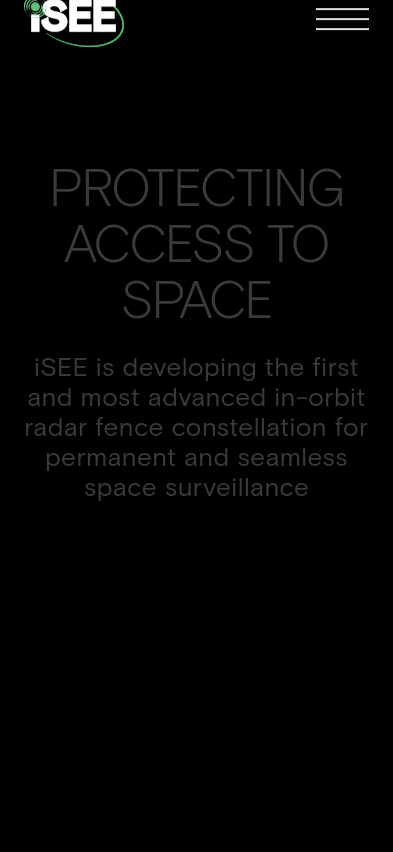
Offers AI-powered space surveillance for tracking debris and enhancing space safety.
iSEE's Key Focus Area
iSEE, short for Impact Space Expedition and Exploration, concentrates on enhancing space safety and security by advancing space surveillance technologies. Their primary focus is on developing and deploying the first in-orbit radar fence constellation. This technology aims to continuously monitor and track space objects in real-time, providing seamless space domain awareness.
Unique Value Proposition and Strategic Advantage
-
In-orbit Radar Fence Constellation: iSEE claims to deliver a unique and advanced system for permanent and seamless space surveillance, which is purported to be the first of its kind. This allows them to detect space objects larger than 2 centimeters twice per orbit and provide numerous tracking measurements per detection.
-
Seamless Space Surveillance: Their technology integrates in-situ AI processing with radar scanning and impact detection, enabling automated decision-making. This capability offers satellite operators potential compliance with Space Situational Awareness (SSA) and sustainability requirements.
-
Comprehensive Solutions: iSEE offers various services, including commercial collision warnings, maneuver optimization, and governmental services like maneuver detection and classification, surveillance, and proximity alerts.
Delivery on Their Value Proposition
-
Technology Demonstration Missions: iSEE has launched missions named Adler-1 and Adler-2, demonstrating radar and particle impact detector technologies to enhance their capabilities in space domain awareness.
-
In-Orbit Radar Features:
- Long-range 3D monitoring of objects and debris in Low Earth Orbit (LEO).
- Enhanced positioning accuracy and orbit determinations.
- Supports optimized maneuvering to respond to and mitigate potential threats or collisions.
-
Digital Twin Technology: Their use of the Digital Twin (SOPE) allows for the simulation of the known LEO object environment based on real-world data and iSEE's own radar data outputs. Users can add models of new objects or predictive statistical debris for future catalog updates.
-
24/7 Monitoring: Their system is designed to continuously protect space assets by ensuring ongoing watchfulness and preparedness for threat mitigation. This aligns with their strategic focus on preventing asset loss and sustaining service availability.
-
Client-Centric Space Traffic Management: By offering client-specific insights from their comprehensive space environment data, iSEE facilitates more effective space traffic management and decision support capabilities.
Overall, iSEE positions its offerings as foundational to maintaining and enhancing safe access to space amidst rising satellite traffic and debris-related risks. The company highlights its pioneering technology approach and priding itself on providing sophisticated tools for risk management and operational efficiency in space exploration and surveillance.
Hyperspec AI
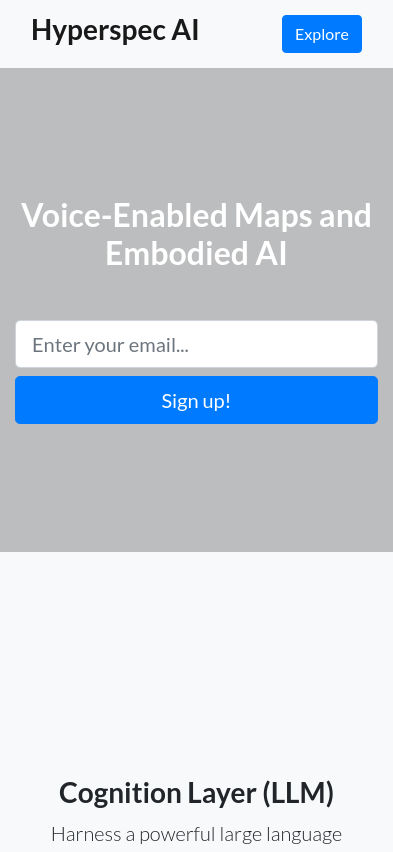
Combines multisensor data with AI to provide insights for environmental monitoring and autonomous navigation.
Hyperspec AI Overview: A Business Perspective
1) Key Focus Area: Hyperspec AI is dedicated to the intersection of artificial intelligence and autonomous technology, with a particular emphasis on robotics and AI for complex decision-making and real-time data integration. The company harnesses a powerful large language model (LLM) to process map metadata, sensor data, and domain-specific knowledge. Their solution is aimed at crafting adaptive AI systems capable of functioning dynamically across changing environments.
2) Unique Value Proposition and Strategic Advantage: Hyperspec AI’s strategic advantage lies in its robust cognitive framework that unifies various data streams—visual, LiDAR, radar, and GPS—into a coherent intelligence system. This seamless integration enables autonomous agents to not only gather but also interpret and respond to real-world variables effectively. Their solution offers these distinct capabilities:
- Generative Policies and Code: Dynamically generate and modify operational guidelines and code, facilitating rapid response to changing compliance requirements and accelerating development workflows.
- Real-Time Sensor Fusion: High-fidelity 3D maps are continuously updated with live sensor data, allowing users to maintain situational awareness and gain geospatial insights.
- Agentic AI: Embedding decision-making agents within applications to enhance user experience and ensure that AI systems can learn and adapt autonomously.
3) Delivery on Value Proposition: Hyperspec AI delivers its propositions through several key offerings and technological innovations:
- Cognition Layer (Large Language Model): Utilizes a sophisticated language model to integrate and analyze map and sensor data, driving informed decision-making.
- Workflow Orchestration: Automates mission-critical processes with intelligent orchestration capabilities, handling task dependencies and optimizing productivity.
- Voice & Maps for Enterprises: Empowers businesses by integrating voice commands with advanced geospatial data, streamlining activities from site planning to data analysis.
The company is actively engaging with modern enterprises that benefit from these solutions, positioning itself as an enabler of improved operational productivity through advanced AI-driven insights.
Conclusion: Hyperspec AI positions itself at the frontier of AI and autonomous technologies by focusing on the development of cognitive capabilities in robotics systems. Through innovative solutions such as real-time sensor fusion, generative policies, and agentic AI, it offers unique advantages in dynamic environments that demand constant adaptation and real-time decision-making. The suite of solutions aims to enhance productivity and operational efficacy for a variety of enterprise applications, all while grounded in their expertise in computer vision and AI. However, these offerings and claims should be considered marketing positions rather than proven benchmarks, highlighting the need for potential clients to consider practical outcomes and existing case studies.
Kayrros
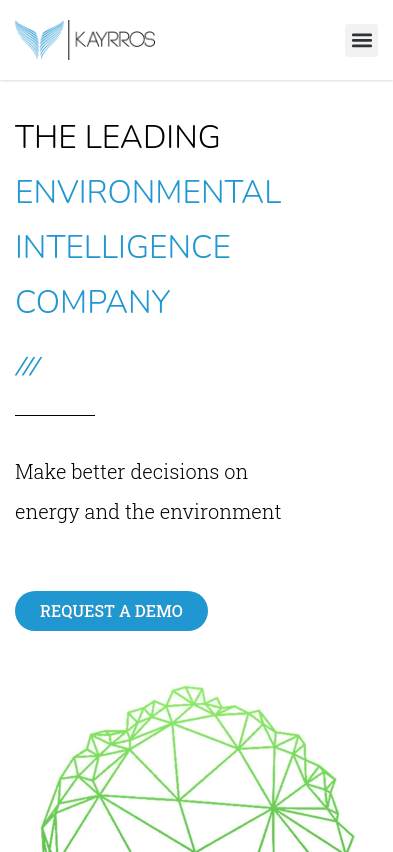
Kayrros is an advanced data analytics company aiding global energy market participants in making better investment decisions. Kayrros is an advanced data analytics company aiding global energy market participants with investment decisions.
About | About | Vision/Values | Vision/Values | Vision/Values | News | About | About | About
-
Key Focus Area: Kayrros focuses on environmental intelligence, specifically addressing greenhouse gas emissions, climate risks, and the energy transition. Its mission includes reducing these emissions, protecting ecosystems and assets, and facilitating the energy transition for various stakeholders.
-
Unique Value Proposition and Strategic Advantage:
- Proprietary Algorithms: Kayrros offers proprietary algorithms that deliver accurate and actionable data streams at the lowest possible cost. These algorithms are built on a strong scientific foundation and are validated by a sophisticated customer base.
- Comprehensive Coverage: The company has the largest mapped database of millions of industry assets and natural ecosystems, which enables comprehensive monitoring and analysis.
- Source-Agnostic Approach: Their approach ensures using the best data sources for generating highly accurate and cost-effective measurements, providing a competitive edge without the need for proprietary satellite imagery.
- Delivery on Value Proposition:
- Use of Satellite and AI Technologies: Kayrros employs satellite-based technology and artificial intelligence to independently measure the environmental footprint of human activities on a global scale. This enables accurate climate governance and monitoring.
- Applications in Key Industries: Kayrros services several industries, including financial institutions, governments, energy, and trading sectors. This breadth ensures that they can meet the distinct needs of various market players, from regulatory compliance to operational efficiency.
- Real-Time Data and Monitoring Tools: They offer tools like Methane Watch, Carbon Watch, and other near-realtime risk and emissions monitoring solutions which cater to operators, traders, and regulators.
- Innovation Studio: By leveraging a vast database of asset measurements, customers can develop proprietary AI models and data streams tailored to their unique needs, enhancing product offerings.
Ultimately, Kayrros positions itself as a facilitator for better decision-making in energy and environmental management, striving to provide independent, reliable, and precise data underpinned by advanced satellite imagery and AI algorithms.
Hayden AI

Hayden AI offers geospatial analytics and transit management services powered by AI technology.
Executive Summary
1) Key Focus Area: Hayden AI is primarily focused on leveraging artificial intelligence and geospatial analytics to solve urban mobility and traffic enforcement challenges. The company specializes in automated bus lane and bus stop enforcement systems, utilizing its AI-powered mobile perception platform. Their focus extends beyond traffic enforcement, aiming to enhance transit efficiency, safety, and sustainability across cities.
2) Unique Value Proposition and Strategic Advantage:
-
Disruptive Technology: Hayden AI claims to provide the only operational AI-based mobile perception platform that integrates data collection, analysis, and real-time enforcement capabilities. The combination of AI and geospatial analytics positions the company to offer comprehensive traffic solutions that can be scaled across various applications, including buses, trams, and other transit services.
-
Privacy First Approach: The company emphasizes data privacy by employing edge processing and encryption. This ensures only necessary information is processed and shared, which appeals to cities and transit agencies focused on maintaining compliance with privacy regulations.
-
Market Leadership: Hayden AI asserts its position as the largest provider of mobile automated bus lane and stop enforcement systems in the U.S., creating a notable market presence and paving the way for expansion into new geographies and markets.
3) Delivery of Value Proposition:
-
Technology Implementation: The core product is an AI-powered camera system placed on vehicles, such as buses, that detect traffic violations with high accuracy using machine learning and computer vision. This system automates the detection of unauthorized parking or movement of vehicles within bus lanes, enhancing transit speed and reliability.
-
Strategic Partnerships: Collaborations with technology partners like NVIDIA, Amazon Web Services, and various local government agencies aid in technological advancement and deployment efficacy. This network favors integration in different urban environments and supports broad deployment capabilities.
-
Sustainability Focus: The platform is designed to reduce emissions by improving transit efficiency and minimizing traffic congestion. Automated enforcement keeps lanes clear, purportedly boosting transit speed, and enhancing service reliability, thereby potentially increasing public transit ridership.
-
Ethical and Governance Framework: Hayden AI has implemented an AI Ethics Oversight Board and framework, aiming to uphold stringent ethical standards in AI usage, addressing concerns related to privacy and bias.
-
Cloud and Edge Computing: The integration of cutting-edge sensor fusion, mapping, edge AI, and cloud computing supports the real-time processing and management of data, allowing efficient scaling and effectiveness of traffic enforcement.
Conclusion: Hayden AI positions itself at the forefront of AI-driven urban solutions, focusing on addressing traffic management challenges with a robust emphasis on privacy and technological advancement. Its market leadership and strategic partnerships further sustain its trajectory towards revolutionizing urban mobility and infrastructure operations. However, the claims and achievements of the company should be viewed with discernment given the promotional context of the information provided.
Perceptive Space
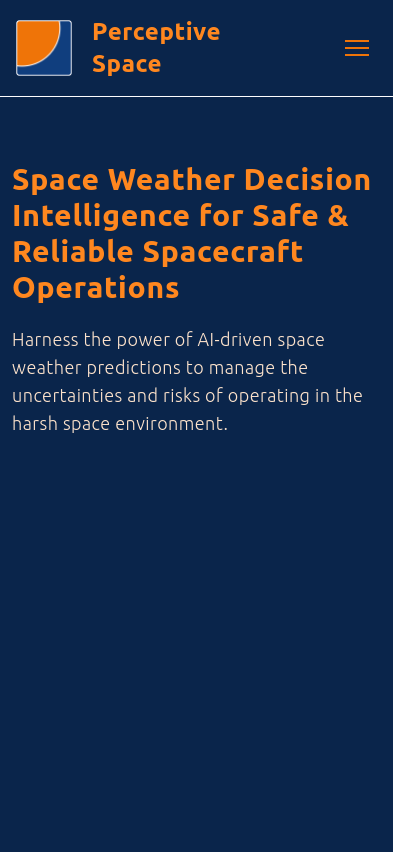
Perceptive Space is creating a space weather platform for safe, reliable operations.
Perceptive Space is focused on developing AI-driven space weather prediction technologies. The company's key aim is to mitigate the uncertainties and risks posed by space weather, which can significantly impact spacecraft operations and other technologies that aim for a sustained presence in space.
Unique Value Proposition and Strategic Advantage:
- AI-Driven Solutions: Perceptive Space leverages advanced AI models to provide highly accurate space weather predictions. These models enhance the precision and reliability of traditional forecasts, which often have to balance between accuracy, update speed, and resolution. The company claims its AI solutions outperform existing models by a significant margin.
- Comprehensive Weather Risk Management: By offering tailored predictions and asset-specific intelligence, Perceptive Space enhances mission lifetimes and minimizes operational downtimes caused by space weather, particularly important for a future with increased space activity.
- Early Access Program: Set to release in 2025, their APIs and dashboards are geared towards Low Earth Orbit (LEO) missions, hinting at a growing interest and clientele focused on increasing weather resilience.
How They Deliver on Their Value Proposition:
- Tailored and Real-Time Solutions: Providing real-time updates and hyper-local forecasts specifically tailored to an orbit and mission design, Perceptive Space aims for precise service that matches the specific needs of spacecraft operations.
- Seamless Integration: User-friendly APIs and dashboards facilitate easy integration into existing systems, allowing companies to adopt this new technology without overhauling their current operations.
- Decisive Insights: Emphasizing not just information but actionable insights, their platform supports decision-making processes by suggesting actionable recommendations rather than raw data.
- Experienced Team: The team comprises experts in AI and aerospace fields with substantial experience from credible institutions like NASA and MIT. This expertise supports the company's capability to innovate and deliver advanced space weather models.
- Secured Funding: Support from notable investors like Panache Ventures and tech strategy endorses their capacity to expand and perfect their offerings.
In essence, Perceptive Space sees its role as providing a crucial piece of infrastructure for the future of space exploration—a future greatly dependent on enhanced space weather prediction capabilities to maintain both human and technological activities beyond Earth. They are positioning themselves to be a necessary partner in the growing space economy by offering precise, reliable, and actionable space weather intelligence powered by AI technology.
Ambient.ai

Ambient.ai is a computer vision intelligence company enhancing enterprise security by using AI to prevent incidents before they occur. They apply advanced computer vision intelligence to existing camera and sensor infrastructures to automate security monitoring and resource dispatching efficiently.
Key Focus Area:
Ambient.ai concentrates on transforming physical security systems by leveraging the power of artificial intelligence and computer vision technologies. Their offerings primarily focus on enhancing safety through innovative software solutions that provide threat detection and response, signals intelligence, forensics, gun detection, and occupancy insights.
Unique Value Proposition and Strategic Advantage:
The company's unique value proposition lies in its use of AI and computer vision to deliver automated and precise threat detection capabilities. This approach seeks to improve physical security operations by reducing human error and enabling proactive measures against potential threats. Ambient.ai positions itself strategically by offering intelligence-driven solutions that aim to optimize security outcomes while minimizing response times and alert fatigue through advanced video analytics and integrated security platforms.
How They Deliver on Their Value Proposition:
-
Platform Capabilities:
- Threat Detection & Response: Ambient.ai provides a framework for monitoring and identifying threats in real-time. It focuses on proactive threat assessments and rapid decision-making to mitigate possible incidents.
- Signals Intelligence: The platform aggregates data from various sources to deliver actionable intelligence, accentuating the role of AI in interpreting and acting on complex security signals.
- Forensic Analysis: Advanced AI models enhance investigative processes, allowing for comprehensive post-incident reviews and identifying improvements for future prevention.
- Gun Detection and Occupancy Insights: Specialized features include gun detection applications and managing occupancy levels to maintain security compliance, especially in sensitive environments.
-
AI Integration:
- Their systems are integrated with AI-powered forensics, which streamline investigations, and access control systems, automating threat detection and response mechanisms. This integration seeks to foster collaborative incident management among security teams.
-
Customer Engagement:
- Ambient.ai showcases success stories, including partnerships with corporations like VMware and institutions such as The Harker School, indicating their broad applicability across diverse contexts, from corporate campuses to educational facilities.
- Alliances with partners like Brivo and Axis Communications further enhance their reach by providing integrated solutions for more effective workplace security.
-
Resource Provision:
- The company maintains a Resource Hub, a centralized location for educational content, allowing customers to learn about optimizing their security posture. This includes webinars, guides, and case studies on using AI for physical security enhancements.
-
Commitment to Innovation:
- Ambient.ai continually updates its platform with new capabilities such as weapon and early-warning detection. It remains focused on addressing contemporary security challenges, including workplace violence and perimeter security, through ongoing enhancements and development of new threat signatures.
In conclusion, Ambient.ai targets the physical security market by offering AI and computer vision software designed to reduce response times and enhance the operational efficiency of security teams. Their strategic use of technology aims to transform how businesses and institutions manage physical security, emphasizing the importance of automation and intelligence in contemporary threat detection and response.
FlyPix AI
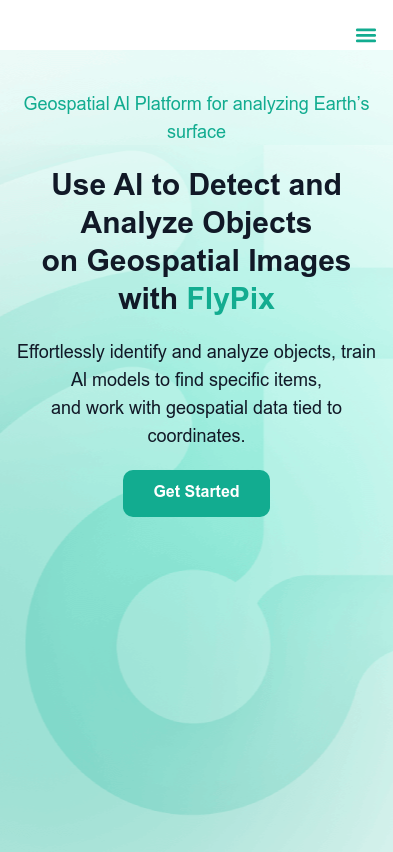
FlyPix AI specializes in converting aerial imagery into actionable, geo-referenced insights using advanced AI. Their platform is used across various sectors, including government, construction, and agriculture, offering object detection, tracking, and monitoring solutions.
FlyPix AI specializes in geospatial analytics, offering a platform that leverages artificial intelligence for the detection and analysis of objects in geospatial images. This platform is particularly designed to cater to various industries by transforming geospatial data into actionable insights.
Key Focus Area:
- The company's primary focus is on providing advanced analytical capabilities in geospatial imaging. Their solutions are applicable across numerous sectors including agriculture, construction, renewable energy, and government.
Unique Value Proposition and Strategic Advantage:
- FlyPix AI's unique selling point is its ability to automate and enhance the efficiency of object detection in geospatial imagery without the need for deep technical expertise. It allows users to perform complex geospatial analysis through a user-friendly, no-code platform.
- The strategic advantage lies in the platform’s compatibility with a wide array of data sources such as satellite, drone, hyperspectral, LiDAR, and Synthetic Aperture Radar (SAR) imagery. This flexibility allows it to cater to a broad spectrum of analytical needs across various industries.
How They Deliver on Their Value Proposition:
- FlyPix AI provides customizable AI models which users can train to meet specific detection needs, contributing to industry-specific solutions.
- Users can interact with the platform through an intuitive interface that facilitates model training without programming knowledge. This democratizes access to sophisticated geospatial analytics tools.
- The platform supports seamless scalability, enabling users to handle large volumes of data effectively. It also features interactive map visualization tools for the analysis and monitoring of patterns in geospatial data.
- To further simplify usage, FlyPix AI integrates easily with existing GIS platforms and offers personalized training to optimize the use of its tools.
- Their strategic partnerships with major players like NVIDIA, IBM, and Google for Startups provide additional technological resources and support, enhancing the robustness of their solutions.
By providing a scalable and versatile geospatial analytics platform, FlyPix AI supports various industries in their operational, environmental, and strategic planning through advanced data analysis and actionable insights.
Adasky
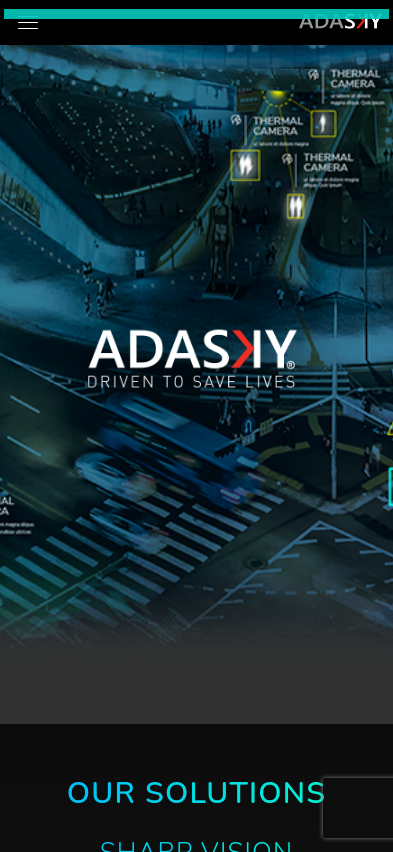
Adasky develops and markets advanced thermal imaging technology for automotive and autonomous sensors.
About | About | Jobs | Vision/Values
Adasky: Business Focus and Value Proposition
Key Focus Area
Adasky, founded in 2016 in Northern Israel, is dedicated to the development and manufacture of intelligent thermal sensing technologies aimed at road safety and automated vehicles. At its core, the company's mission is to address safety in transportation and smart city infrastructure, leveraging thermal cameras that operate regardless of lighting or weather conditions to enhance vehicle automation and urban roadway safety.
Unique Value Proposition and Strategic Advantage
-
Thermal Sensing Technology: Adasky's thermal sensing systems seek to bridge perception gaps present in conventional sensor technologies used in automated vehicles. Thermal cameras by Adasky are noted for their ability to detect and classify objects up to 300 meters, with a particular advantage in recognizing living beings at over 200 meters in all conditions, including complete darkness and adverse weather. Unlike other sensors, these cameras are engineered to operate continuously without the need to "blink" for recalibration, providing uninterrupted functionality.
-
Flexibility and Adaptation: Initially focused on vehicle safety, Adasky has expanded its scope to include smart city solutions, using similar technology for fixed installations aimed at maintaining safety for all road users. The company also adapted its technology in response to the COVID-19 pandemic, utilizing thermal detection capabilities to monitor body temperatures in public settings.
-
Cost-Effectiveness and Scalability: With a focus on scalability, Adasky offers its thermal sensing technologies at a price point that purportedly makes safety systems accessible to a wider market, aiming to democratize mobility safety enhancements.
Delivering Value
To deliver on their value proposition, Adasky employs several strategic methods:
-
In-House Development: Both software and hardware components of the ADASKY Thermal Camera systems are developed and manufactured in-house. This integrated approach ensures quality, compatibility, and provision of a customizable safety layer for automated systems, which operates via a 360-degree protective sphere around vehicles.
-
Advanced Algorithms and Features: The company's approach includes the integration of advanced computer vision algorithms capable of object detection, free-space identification, and Time to Collision calculations that bolster safety features like Forward Collision Warning and Automatic Emergency Braking.
-
Partnerships and Collaborations: Adasky's strategic partnerships with organizations such as Gentex, SWARCO, and Imagry enhance their market reach and capability. These collaborations target specific road safety enhancements and integration of thermal imaging in advanced driver-assistance systems and autonomous vehicle platforms.
-
Adaptable Solutions for Infrastructure: Adasky presents its Sharp Vision as a stationary LWIR thermal imaging system, which is designed to be easily integrated into existing smart city infrastructure. This solution, which features real-time classification capabilities, is put forward as more economical, encompassing, and providing an extensive detection range.
Adasky's focus is on continuing to innovate within the thermal sensing industry, asserting its product offerings as comprehensive solutions to current and emergent safety challenges in both automotive and public infrastructure contexts.
Adversa

Adversa automates red teaming activities, enhancing organizations' abilities to assess their security guardrails' robustness against AI model threats.
About | News | About | About | About | About | About | Management | About | About | About | About | About | About | About | About | About | News | About | About
Adversa AI, an Israeli AI startup, focuses on securing artificial intelligence primarily through the protection of AI systems from cyber threats, privacy issues, and safety risks. Their key focus revolves around providing security solutions for AI to various industries such as finance, insurance, automotive, biometrics, and more. By identifying and managing the myriad of AI risks specific to different sectors, Adversa seeks to create more secure and trustworthy AI environments.
Unique Value Proposition and Strategic Advantage:
- Comprehensive AI Security: Adversa AI positions itself uniquely by offering complete solutions for AI systems' safety across industries. They deliver security awareness, assessment, and assurance that help clients protect their AI models from various threats such as adversarial attacks or data leakage.
- Research and Innovation: The company has developed pioneering technologies for secure AI, which have been recognized in multiple industry reports and conferences. Their research includes methods to navigate the security challenges in AI models, such as Large Language Models (LLMs).
- Collaborative Approach: Adversa AI places emphasis on partnerships with industry and technology leaders to further the development and implementation of secure AI practices.
Delivery on Value Proposition:
- Secure AI Awareness: Adversa provides services to help organizations develop an understanding of AI risks and integrate these insights into their governance strategies. This includes policy development, training, and threat intelligence to keep organizations informed about the latest industry threats.
- AI Integrity Assessments: Adversa offers AI integrity validation and vulnerability identification services. They employ threat modeling and vulnerability audits to understand potential exploits of AI systems and provide recommendations for strengthening security.
- Continuous Red Teaming: Adversa's continuous AI Red Teaming involves ongoing attack simulations to identify and mitigate emerging threats in AI applications. This includes testing for unknown risks unique to specific client applications.
- Trusted AI Development: They support organizations in developing and monitoring secure AI by offering solutions that integrate controls and provide operational security assurance.
- Industry-Leading Insights: Continuously engaging in cutting-edge research and industry dialogue, Adversa provides insights and thought leadership on AI security. Their platforms allow companies to stay abreast of trends, predictions, and vulnerabilities affecting AI technology.
In essence, Adversa AI aims to be a pioneer in advocating and realizing secure and trustworthy AI systems by addressing the complex landscape of cyber threats that organizations face in AI deployment. Through a combination of proprietary technology, strategic research, and industry collaboration, they aim to position themselves as key facilitators in the journey toward resilient AI practices.
Mighty AI

Mighty AI provides training datasets and models for artificial intelligence applications. It focuses on computer vision and natural language processing to enhance machine learning capabilities.
Aurora Innovation Inc.: Overview and Strategic Insights
1. Key Focus Area: Aurora Innovation is primarily dedicated to the development and implementation of autonomous driving systems. The company's core product, the Aurora Driver, is a sophisticated autonomous driving technology designed for both freight and passenger transportation. They aim to revolutionize the logistics and ride-hailing sectors by integrating this technology into vehicles ranging from sedans to semitrucks.
2. Unique Value Proposition and Strategic Advantage: The central value proposition of Aurora lies in its high-level autonomous driving system, which promises enhanced safety, increased operational efficiency, and a more consistent driver supply.
- Autonomous Technology: The Aurora Driver's core strength is its advanced sensing and computing system, which can handle complex driving environments and integrate into a wide range of vehicles. Aurora's proprietary FirstLight Lidar extends visibility up to 400 meters, promising quick reaction times and safety.
- Industry Collaborations: Strategic alliances with industry leaders like Volvo, PACCAR, and Toyota, along with Uber for ride-hailing, demonstrate their commitment to a collaborative approach in scaling autonomous vehicle technology. These partnerships are crucial for developing vehicles that both accommodate the autonomous systems and are manufacturable at scale.
- Scalability in Freight: Aurora is developing freight solutions that address current challenges like driver shortages and efficiency. By offering technology that bypasses human driver limitations, they propose solutions that could significantly reduce transit times.
3. Delivering on the Value Proposition: Aurora achieves its strategic aims through several key initiatives:
- Comprehensive Autonomous System: The Aurora Driver combines a robust hardware and software architecture, employing high-definition mapping and simulation to teach and test its systems virtually, ensuring that the technology continues to learn and adapt.
- Pilot Programs and Real-world Testing: Using partnerships with logistics companies and automakers, they conduct pilots to integrate their technology into existing networks. These pilots help refine the autonomous systems for real-world conditions and help their partners transition smoothly into using the technology.
- Safety as a Cornerstone: Safety is emphasized through the company’s Safety Case Framework, which outlines the foundational safety underpinnings of their technology, development processes, and organizational behavior. This includes a safety management system that reviews and acts upon any reported concerns.
- Integration with Logistics Systems: The Aurora Driver supports logistics companies by offering seamless integration with existing transportation management systems. This allows businesses to adapt quickly and potentially realize efficiency gains.
- Commitment to innovation: Aurora continues to invest in technological advancement and scalability, backed by significant funding and strategic financial management.
In summary, Aurora Innovation positions itself as a trailblazer in autonomous technology with multi-industry applications. Their strategy is rooted in leveraging advanced technology, forming strategic partnerships, and prioritizing safety to drive adoption and transform both the freight and ride-hailing industries.
Syensqo
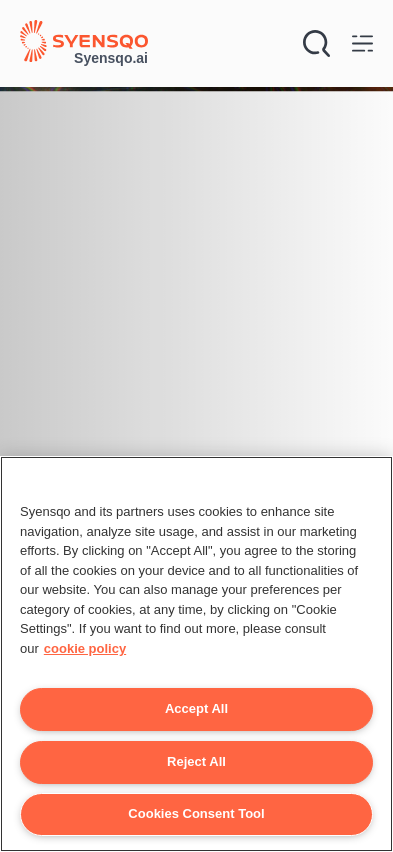
Syensqo is a company focused on scientific exploration and breakthroughs that advance humanity. They offer a diverse portfolio of products and solutions across various sectors such as battery materials, thermoplastic composites, and renewable materials.
Syensqo.ai is positioned in the niche sector of artificial intelligence (AI) applications for the chemical industry. Their key focus is on leveraging AI to transform various facets of this $5 trillion global industry. Their aim is not merely to make small improvements but to introduce breakthroughs that drive significant advancements in chemical processes, operations, and materials development.
Key Focus Area:
- Revolutionizing the chemical industry by applying AI to:
- Materials Discovery: Utilizing machine learning to innovate new materials.
- Manufacturing Optimization: Enhancing production quality through AI-powered analytics, often referred to as the “Golden Batch” approach.
- Operational Efficiency: Applying AI tools for streamlined operations across departments, including sales and supply chains.
Unique Value Proposition and Strategic Advantage:
- Syensqo.ai differentiates itself by investing heavily in vertical AI applications specific to the chemical industry, setting itself apart from generalized AI service providers.
- Their strategic advantage lies in their deep industry expertise and collaboration with key industry players, such as Microsoft, to ensure rapid development and deployment of AI solutions.
Delivery on Their Value Proposition:
- Strategic Partnerships: The collaboration with Microsoft for the Azure OpenAI Service exemplifies their strategy of leveraging external expertise to accelerate development. This partnership enabled the rapid creation of SyGPT, an AI chatbot aimed at improving data access and operational efficiency.
- Innovative Solutions: The development of SyGPT showcases Syensqo's commitment to operational excellence by providing secure and efficient data query solutions to enhance decision-making processes.
- Focus on Cybersecurity and Responsible AI: Syensqo emphasizes cybersecurity and responsible AI use—principles they embed into their product and solution development.
- Data Protection and Compliance: The company also adheres to stringent data protection standards, complying with the EU General Data Protection Regulation (GDPR), underscoring their commitment to ethical data usage.
In summary, Syensqo.ai's focus on AI-driven transformation of the chemical industry is evident in their strategic partnerships, targeted AI solutions, and commitment to data protection. They aim to not just keep pace with but lead the industry through significant technological advancements and operational efficiencies powered by AI.